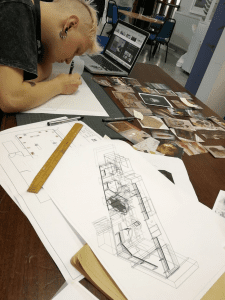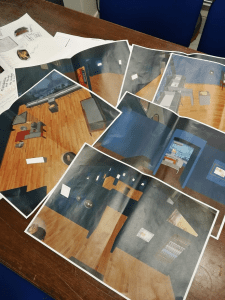Designing the exhibition space
Posted on by Fay Curtis.
by Anika, Marcin and Maisie – the Young Exhibition Producers
We are the team working with Bristol Museum & Art Gallery to produce an additional exhibition to complement Leonardo da Vinci: A Life in Drawing. At this stage of the project we are starting to work on the design of our exhibition.
We started with a design brief – the museum staff do this using a template which walks through all the things to consider. A design brief should include:
- Big idea, why are you doing it?
- What are your general objectives?
- Who is your target audience?
- What story or theme do you want to explore?
- What different types of media is available for you to use?
- What are your requirements? (i.e. storage, accessibility)
- What are your constraints?

Next it is important to start gathering ideas. Pinterest is a really useful research tool for this part. I had never had to think about designing something in a three dimensional space before, so brainstorming on Pinterest and seeing what other designers had done was a really important step in imagining how the space would physically feel.
On projects like this there are often multiple people working on producing the exhibition – exhibition designers, marketing, curators, engagement, funding, conservation etc. so by everyone using the same Pinterest board all parties can effectively be on the same page. This is vital as it is important for everyone to have a shared vision of how the exhibition should be.
There are then three stages of the design process and these should be engineered to fit the design brief.
Concept design
This stage is all about dreaming big and selling the big idea. We started making 3D sketches of how we wanted the space to look. As we did more of these we got a better idea of what we liked and didn’t like.
Scheme design
This is about being more realistic and making decisions about what we liked from our concept design. We looked at feedback from the concept design and used it to create a more solid vision of a space that satisfied our brief.
Produce elevations of your planned space and present exactly where things will go to management. It then needed to be signed off by relevant parties to ensure it would fit within the constraints.
Detailed design
This part is all about ironing out the details and making final plans and elevations of the space. What is the specific size of everything? Do mounts need to be made to hold certain objects? Who is responsible for each element being correctly executed?
Detailed design may also include some value engineering – when certain elements end up over budget so a cheaper compromise must be made instead.
